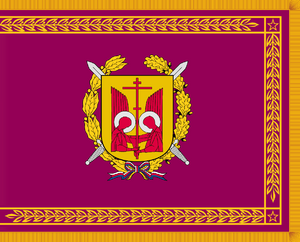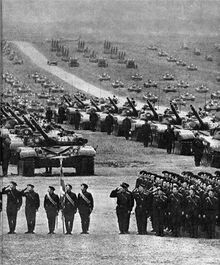Dulebian Armed Forces: Difference between revisions
The ©rusader (talk | contribs) m (→Great game) |
The ©rusader (talk | contribs) m (→Great game) |
||
| Line 59: | Line 59: | ||
{{main|People's Republic of Dulebia}} | {{main|People's Republic of Dulebia}} | ||
[[File:Voskhod 1975.jpg|thumbnail|left| | [[File:Voskhod 1975.jpg|thumbnail|left|220px|Voskhod-1975, the biggest military exercise in the military history of Dulebia.]] | ||
After the end of the Dulebian Civil War, the military forces of the Dulebian People's Republic were drastically reformed into the Dulebian People's Army ({{wp|Russian language|Dulebian}}: ''Народная Армия Дулебии''). Most of the former officers were either purged, killed during the civil war or expelled from the country. Former imperial military schools were closed. Repressions were performed in the defence industry of the country. The armed forces were put under the direct control of the Dulebian Communist Party already during the civil war, but the reforms of Konev made the Ministry of Defence the formal supervision authority during peacetime. | After the end of the Dulebian Civil War, the military forces of the Dulebian People's Republic were drastically reformed into the Dulebian People's Army ({{wp|Russian language|Dulebian}}: ''Народная Армия Дулебии''). Most of the former officers were either purged, killed during the civil war or expelled from the country. Former imperial military schools were closed. Repressions were performed in the defence industry of the country. The armed forces were put under the direct control of the Dulebian Communist Party already during the civil war, but the reforms of Konev made the Ministry of Defence the formal supervision authority during peacetime. | ||
Revision as of 16:37, 15 May 2022
| Dulebian Armed Forces | |
|---|---|
| Вооруженные силы Республики Дулебия | |
 Banner of the Dulebian Armed Forces | |
| Founded | 1724 (as the Imperial Dulebian Army) |
| Current form | 1 December 1995 |
| Service branches | |
| Headquarters | Ulich, Dulebia |
| Leadership | |
| Supreme Commander | |
| Minister of Defence | |
| Chief of the General Staff | |
| Manpower | |
| Military age | 18 |
| Conscription | Yes |
| Available for military service | 21,077,703 (2021), age 18-32 |
| Fit for military service | 17,083,554 (2021), age 18-32 |
| Active personnel | 76,000 (2021) |
| Reserve personnel | 185,000 (2021) |
| Expenditures | |
| Budget | Ћ46.6 billion (US$20.9 billion)(2020) |
| Industry | |
| Domestic suppliers | Arms industry in Dulebia |
| Foreign suppliers | |
| Annual exports | Ћ0.52 billion (US$0.23 billion) (2018) |
| Related articles | |
| History | Military history of Dulebia |
| Ranks | Dulebian Armed Forces ranks and insignia |
The Dulebian Armed Forces (Dulebian: Вооруженные силы Республики Дулебия, tr. Vooruzhonnye Sily Respubliki Dulebiya) is a collective term describing the combined military forces of Dulebia, consisting of its Army, Air Force and Navy. The coomander-in-chief of the Dulebian Armed Forces is the President of Dulebia (currently Alexey Volodin).
The history of the Armed forces of Dulebia can be traced byck to the reforms of Peter II the Great in the 1720s. Following the establishment of the Dulebian Empire in 1721, he proceeded to reform its armed formations into a modern Berean army - it was rearmed, retrained and structured in a way similar to that of most Berean empires at the time. It also received a western-style command structure, with the first professional military school in Dulebia being established in 1722. This reformed army showed its effectiveness in the upcoming years in the numerous wars against Dulebia's neighbours. Following the Second Dulebo-Gurkhan War Dulebia received its first naval forces, which rapidly expanded in the 19th century and proved their effectiveness in the Karsk Sea War. In the early 20th century the country also established its Air Fleet Corps, the predecessor of the modern Air Force of Dulebia. After the Dulebian Revolution, the military of the country was once again reformed and restructured, with many of its former commanders fleeing the country or being purged in the early years of the Soviet regime in the country. Despite that, the Dulebian armed forces in the 20th century were one of the biggest in Berea, and one of the few to obtain nuclear weapons in the second half of the century. Following the collapse of the socialist regime in Dulebia, its armed forces were reformed and reorganized. The poor economic situation in the country led to a rapid deterioration of its military, as well as a collapse of the defence industry that was constructed in the decades prior.
Today the Dulebian Armed Forces are a small but potent power in Berea. With an annual spending of Ћ46.6 billion (US$20.9 billion), which forms 2.85% of the country's GDP, the country is around the middle of the list of Berean countries by military spending. Despite numerous reforms and spending increase since the early 1990s, the armed forces still remain equipped mainly with outdated 20th century equipment dating back to the People's Republic of Dulebia. The country is cuurently supplied mostly by its own defence industry, which has seen growth in the first decade of the 21st century due to rising foreign interest in Dulebian military export. While plans to modernize the military and switch to a contract army have been announced, the government spending on the military has been dropping ever since the early 2010s, making all these modernization attempts difficult.
History
Dulebian Empire
Great War
Great game
After the end of the Dulebian Civil War, the military forces of the Dulebian People's Republic were drastically reformed into the Dulebian People's Army (Dulebian: Народная Армия Дулебии). Most of the former officers were either purged, killed during the civil war or expelled from the country. Former imperial military schools were closed. Repressions were performed in the defence industry of the country. The armed forces were put under the direct control of the Dulebian Communist Party already during the civil war, but the reforms of Konev made the Ministry of Defence the formal supervision authority during peacetime.
Following the death of Konev, the Dulebian armed forces were greatly expanded. The reestablishment of diplomatic relations with other Berean states allowed for the flow of technologies and specialists into Dulebia during its industrialization, and numerous secret treaties with Cuthland allowed for Dulebia to modernize its military equipment. Under the policy of the Perekovka Dulebia supported communist movements across the world, and its armed forces intervened directly in the Lavarian Revolution in 1936.
In the 1950s Dulebia became the third country in the world to obtain nuclear weapons. Its military was also ranking among the biggest in the world, with almsot one fourth of the male population serving in the military in one form or another. Dulebia fielded the biggest fleet of strategic bombers capable of carrying nuclear weapons. During the final decades of the communist regime of the country, its military became underfunded and underequipped. The strategic bomber force was disbanded in 1982, and the Dulebian People's Navy could nbot perform even patrol duties in the Karsk sea due to systematic underfunding. While on paper it still obtained the third biggest stockpile of nuclear weapons in the world, by 1990 most of that stockpile was outdated and could not be fielded.
